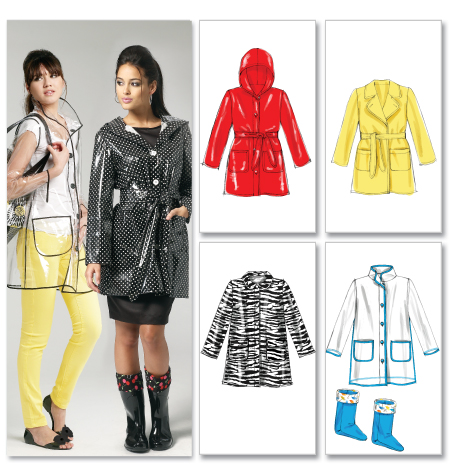Here is my review of McCall's 6517.

Description from the back of the envelope: Misses' jackets, belt and boot liners: Loose-fitting, unlined jackets, A. B, C, D have self-lined hood or collar and narrow hem. B: purchased bias tape finishes garment. C: flaps. A, B, C: mock front bands. D: Wrap, self-belt. Boot liners E have pleated heel and cuffs.
Pattern sizing for this pattern is B5 (8 to 16) or F5 (16 to 24). I made a size 14-ish based on the finished garment measurements printed on the pattern tissue.
As I stated above, I used a laminated cotton from Amy Butler. It was half-price, 60" wide and I used about 2.5 yards for the coat. The lining is from Fabric.com--incidentally, it was the only place I could find this color of lining! The buttons were from my stash.
I made view A, without the belt. I actually made the belt, but decided it looked funny so I won't wear it.

Instructions are fine, except for step 26. In this step, you have attached the hood and are supposed to trim the seam allowance and then turn the fabric under covering the seam. I hope this makes sense! Did the pattern makers actually try this will three layers of laminated fabric? I enclosed this seam with some very pink bias tape and a decorative stitch. It adds another pop of color to the already colorful coat!
 This pattern is listed as easy, but before a beginner jumps on this make sure you have the right tools in order to get a good result. I read quite a few blogs before I embarked on this coat. Having said that, it went together really well, was easy--mostly since I had the right tools to make it easy!
This pattern is listed as easy, but before a beginner jumps on this make sure you have the right tools in order to get a good result. I read quite a few blogs before I embarked on this coat. Having said that, it went together really well, was easy--mostly since I had the right tools to make it easy! 
Here is what I did:
1. I sprayed the tissue paper pieces with 505 adhesive spray. You do not want to use pins as they will leave permanent holes in the fabric.
 2. I lined the pockets with my lining fabric to ensure a good (pretty good) smooth edge when you sew them onto the coat front. Since you can't pin, I used a fabric glue stick to baste to the coat and them sewed around them.
2. I lined the pockets with my lining fabric to ensure a good (pretty good) smooth edge when you sew them onto the coat front. Since you can't pin, I used a fabric glue stick to baste to the coat and them sewed around them.  3. Use a walking foot. I can't tell you how much this fabric will stick to your throat plate. If you don't have one, get one. A Teflon foot will help, but the fabric will still stick to the metal plate.
3. Use a walking foot. I can't tell you how much this fabric will stick to your throat plate. If you don't have one, get one. A Teflon foot will help, but the fabric will still stick to the metal plate. 4. Lining. This coat didn't call for a lining. I put one in using the pattern pieces. I also opted to line the hood with my lining fabric rather than the laminated cotton. This seemed to be a good solution as the coat fabric got a little thick sewing the hood on. Had I used three layers of the cotton, I wouldn't have gotten as nice of a result.
5. Sleeves: I bagged the sleeve lining. This made it easier to get a nice hem on the sleeve. I still topstitched the edge so it laid crisper. There is quite a bit of ease in the sleeve cap. If you stitch slowly and maneuver your fabric to avoid puckers, you will be okay. Take it s-l-o-w.
6. While you may be tempted to omit the stay stitching at the neckline, don't. You need the reinforcement there in order to clip the neck-edge and fit the hood to the garment.
7. Speaking of the hood, I try to be rather precise, so I did use some pins in order to line up the seams on the cotton and lining fabric so when I topstitched, both pieces lined up nicely. I ran the pins parallel to the seams, on the seam lines and it worked great. Again, sew slowly.
8. Hemming. To hem the coat, I knew I couldn't press so I stitched 1" from the bottom, turned 1/2" and stitched 3/8" using a decorative stitch to hold the fabric and lining in place. Next, I turned the fabric another 1/2 inch and stitched another 3/8 from the bottom. No pins were required!
9. I used a size 12 Sharp needle from Schmetz. This worked well. A larger needle will leave bigger holes in your fabric.
10. I backed my buttons with small, white buttons to keep them from pulling through the fabric.
All in all, I love my raincoat! It is pretty roomy, so keep that in mind if you decide to whip this up!
Alterations:
My usual 1/2" sway back adjustment. This fabric has no give, so I folded the tissue a the waist and tapered it to nothing at the side seam on both the cotton and lining.
I lowered the pockets about 1 inch so they fit where my hands naturally would fit into a pocket.
Conclusion:
I do recommend this coat to others. It has some fun possibilities using various fabrics.
Thanks for reading!
Sue

No comments:
Post a Comment